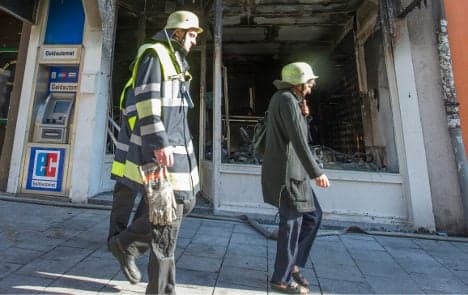Munich bomb blows open compensation question

The detonation of a WWII bomb in Munich's Schwabing district on Tuesday caused massive damage to surrounding buildings, leaving a huge, unanswered question about who would pay to fix it all, as well as a big hole in the ground.
No one was hurt, Jörg Fiebach, chief of the Munich fire brigade, told journalists in Munich on Wednesday. But half of one house was almost completely burned out, and many windows were shattered in the blast. Several buildings were set on fire by flying burning chunks of straw from the bomb site.
The extent of the damage is still unclear, but is expected to be in the millions of euros. The city council said several houses were uninhabitable, and two are considered to be in danger of collapsing.
A spokeswoman for Allianz insurance company told The Local on Wednesday that although acts of war were excluded from their policy coverage, the company would make an exception and still cover damages to policy holder's homes and belongings.
Pictures of the fireball and its aftermath
It remained unclear whether the city would pay for the damages. Munich Mayor Christian Ude called the issue of liability a "difficult question of law, which will likely end up being decided by experts," but added that "of course, those affected will receive compensation."
But Peter Lueg from the city's Regional Administration Office stressed there was no public liability claim to be made against the city. The detonation was carried out "according to the rules of the art", said Lueg, and the resulting damages were unavoidable. He spoke of "the long-term consequences of war."
Experts said the bomb was American-made, reported Der Spiegel magazine. It had a chemical detonator, consisting of a glass ampoule of acetone, which made the whole thing very unstable. Initial expectations that the bomb could be defused were quickly rejected in favour of a controlled detonation.
Head of Munich’s police Wilhelm Schmidbauer said, "razor-sharp bomb splinters" had been found 300 metres away from the blast site, proving that the decision to evacuate everyone with a 1,000 metre radius was the right one.
Some 2,500 residents were moved from their homes in the central Schwabing district. Although most had returned home by Wednesday afternoon, those with homes closest to the site of the blast were still waiting for the all-clear.
Load-bearing masonry is the typical construction style in the Schwabing area, making a detailed check of external walls imperative, said Norbert Gebbeken, Vice President of the Bavarian Engineering Chamber.
The bomb was discovered underneath the site of the popular "Schwabinger 7" bar on Monday.
After it became clear it would the bomb's chemical delayed-action detonator would make it too dangerous to diffuse, officials detonated it late on Tuesday.
The Local/DAPD/sh
Comments
See Also
No one was hurt, Jörg Fiebach, chief of the Munich fire brigade, told journalists in Munich on Wednesday. But half of one house was almost completely burned out, and many windows were shattered in the blast. Several buildings were set on fire by flying burning chunks of straw from the bomb site.
The extent of the damage is still unclear, but is expected to be in the millions of euros. The city council said several houses were uninhabitable, and two are considered to be in danger of collapsing.
A spokeswoman for Allianz insurance company told The Local on Wednesday that although acts of war were excluded from their policy coverage, the company would make an exception and still cover damages to policy holder's homes and belongings.
Pictures of the fireball and its aftermath
It remained unclear whether the city would pay for the damages. Munich Mayor Christian Ude called the issue of liability a "difficult question of law, which will likely end up being decided by experts," but added that "of course, those affected will receive compensation."
But Peter Lueg from the city's Regional Administration Office stressed there was no public liability claim to be made against the city. The detonation was carried out "according to the rules of the art", said Lueg, and the resulting damages were unavoidable. He spoke of "the long-term consequences of war."
Experts said the bomb was American-made, reported Der Spiegel magazine. It had a chemical detonator, consisting of a glass ampoule of acetone, which made the whole thing very unstable. Initial expectations that the bomb could be defused were quickly rejected in favour of a controlled detonation.
Head of Munich’s police Wilhelm Schmidbauer said, "razor-sharp bomb splinters" had been found 300 metres away from the blast site, proving that the decision to evacuate everyone with a 1,000 metre radius was the right one.
Some 2,500 residents were moved from their homes in the central Schwabing district. Although most had returned home by Wednesday afternoon, those with homes closest to the site of the blast were still waiting for the all-clear.
Load-bearing masonry is the typical construction style in the Schwabing area, making a detailed check of external walls imperative, said Norbert Gebbeken, Vice President of the Bavarian Engineering Chamber.
The bomb was discovered underneath the site of the popular "Schwabinger 7" bar on Monday.
After it became clear it would the bomb's chemical delayed-action detonator would make it too dangerous to diffuse, officials detonated it late on Tuesday.
The Local/DAPD/sh
Join the conversation in our comments section below. Share your own views and experience and if you have a question or suggestion for our journalists then email us at [email protected].
Please keep comments civil, constructive and on topic – and make sure to read our terms of use before getting involved.
Please log in here to leave a comment.